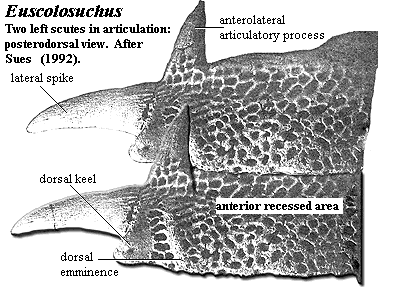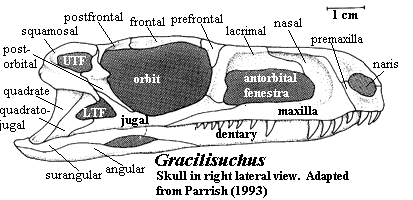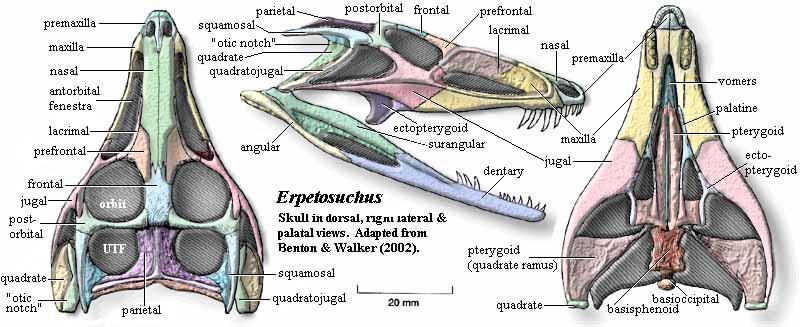
| Palaeos |  |
Archosauria |
| Vertebrates | Other Suchia |
| Page Back | Unit Home | Unit Dendrogram | Unit References | Taxon Index | Page Next |
| Unit Back | Vertebrates Home | Vertebrate Dendrograms | Vertebrate References | Glossary | Unit Next |
|
Abbreviated Dendrogram
ARCHOSAUROMORPHA | `--ARCHOSAURIA |--Proterosuchidae `--+--Erythrosuchidae `--+--Euparkeriidae `--Crown Group Archosauria |--Ornithodira | |--PTEROSAURIA | `--DINOSAUROMORPHA `--Crurotarsi |--Phytosauridae `--Rauisuchiformes |--Rauisuchia | |--Ornithosuchidae | `--+--Prestosuchidae | `--Rauisuchidae `--Suchia |--Aetosauridae `--+--Euscolosuchus `--+--Gracilisuchus `--+--Erpetosuchus `--CROCODYLOMORPHA |
Contents
Overview |
Here, at last we come to the close relatives of the crocodylomorphs, where archosaur phylogeny becomes a bit more straightforward. The basal archosaurs, as we have seen, seem to fall into three basic morphotypes: (a) large, heavy predators, (b) small to medium-sized lightly built forms which were probably insectivores or carnivores, and (c) low-slung, heavily armoured tanks, including both herbivores and carnivores, often (but not always) associated with watery environments. The basal type seems to be (b), the relatively small, lightly-built form -- far from what we think of as the basic reptile type. Yet most undoubtedly basal forms, such as Euparkeria, Scleromochlus, and the Ornithosuchidae, all fall in that range. As Sereno (1991) first noted, there is no consistent trend away from that morphotype. Heavy pacers and croc-like sprawlers diverge from the stem with equal frequency.
The case is no different near the crocodylomorph boundary. Euscolosuchus and, to a lesser extent, Gracilisuchus, appear to tend to the armored sprawler type. However, the sister of Crocodylomorpha, Erpetosuchus, is a very light, very terrestrial form which looks like a sleek, streamlined ornithosuchid.
Euscolosuchus is known only from osteoderms and a few vertebrae. The osteoderms fit closely, overlap, and have a particularly elegant system of strong, but flexible interlocking grooves and projections. the dorsal osteoderms end in intimidating lateral spikes, rather like desmatosuchid aetosaurs. However, their shape and dimensions suggest an animal a good deal leaner than an aetosaur. The vertebrae have conventional, spool-like centra; but the neural arches are strongly specialized to support the armor plates. The dorsal end of the neural spines are broadened, forming a spinal table, and the transverse processes are broad and tilted to support the osteoderms ventrally.
Gracilisuchus was a tiny, lightly built archosaur. It has been variously interpreted through the years; originally as a primitive ornithosuchid by Romer (1972) and Bonaparte (1975), then as a possible crocodylomorph by Brinkman (1981), as a basal member of the Crocodylotarsi Benton & Clark, 1988 (between Parasuchia and Stagonolepididae), and as the sister to the Poposauridae + Crocodylomorpha by Parrish 1993. By contrast, Juul (1994) found Gracilisuchus to be the sister of Postosuchus which in turn was a sister taxon to the Crocodylomorpha (as part of the "Paracrocodylomorpha"). Gower & Wilkinson (1996) placed it in an unresolved trichotomy with Postosuchus and the Crocodylomorpha; while Benton & Walker (2002) concluded that it was outgroup to the clade consisting of Postosuchus + Erpetosuchus + Crocodylomorpha. The consensus therefore is to place it within the general Crocodylomorpha-and-friends lineage. As such, it is the earliest known member of the clade. Interestingly, if Romer's original suspicion was correct and Gracilisuchus is a basal ornithosuchid, that would indicate the validity of Juul 1994's Dromaeosuchia, with Gracilisuchus as a transitional form between (and near the common ancestor of) the Ornithosuchidae and Paracrocodylomorpha.
The best known of this group, and perhaps closest to the Crocodylomorpha, is Erpetosuchus. It shares a number of rather specific characters with the Crocodylomorpha. These include parietals which are completely fused along the midline, loss of the postfrontal, and formation of a fairly complete secondary palate. It also possesses some peculiar apomorphies including a deep "otic notch" and a maxilla and jugal that bend back under the skull. Many Crurotarsal have a ridge at the ventral margin of the skull, but Erpetosuchus is unique in the degree to which the marginal bones are bent back in towards the middle. It is hard to imagine Erpetosuchus with cheeks or jowls -- and it was certainly not an herbivore -- but the general arrangement does remind one of a hadrosaur. In addition, its orbits faced rather anterodorsally, an unusual arrangement for this part of phylospace. Unfortunately, the postcranial skeleton is not well known. It was a lightly built form with unusual, small, and nearly featureless circular coracoids. The hind limbs are completely unknown.
It seems likely that the diversity of these smaller, lightly constructed Crurotarsi is undersampled. Since they seem to be the stem lineage from which more specialized forms developed, the remaining uncertainties of archosaur phylogeny are probably due to our broad ignorance of animals of this type. Unfortunately, Triassic Crurotarsi are not dug out with the frequency of Cretaceous dinosaurs. We may have to wait some time before the path of the tree is much clearer. ATW040131.
 Euscolosuchus:
E. olseni Sues 1992. [2]
Euscolosuchus:
E. olseni Sues 1992. [2]
Range: Late Triassic (middle Carnian) of North America (Eastern US)
Phylogeny: Suchia :: (Gracilisuchus + (Erpetosuchus + Crocodylomorpha)) + *.
Characters: vertebral centra spool-shaped (slightly wider than tall) and small by comparison to neural arches [S92]; neural arches low & very wide [S92]; postzygapophyses widely spaced & overhang posterior surface of centrum & connected to transverse processes by thin lamina of bone extending out along the ventral side of the transverse process [S92]; transverse processes blade-like and axially expanded, with blade rotated ~20° so that dorsal surface faces anterodorsally [S92]; dorsal end of neural spine broadly expanded into a "spinal table" (presumably to support the osteoderms) [S92]; narrow dorsal carapace composed of imbricating pairs of paramedian osteoderms [S92] [1]; posterior cervical & dorsal osteoderms with lateral spikes [S92]; anterior1/3 of each plate is set off by a step [S92]; each plate overlaps the plate posterior to it [S92]; each plate probably with anterolateral articulatory process [S92]; plates bear posterolateral dorsal eminence plus (lateral to the eminence) a much larger dorsal keel [S92]; ornamentation on osteoderms of deep pits [S92];
Notes: [1] this phrase, directly quoted from [S92], appears to be slightly inaccurate. The osteoderms do not overlap their antimeres across the midline. Rather, each plate overlaps the plate posterior to it on the same side of the backbone. [2] The genus is known only from scutes and a few fragmentary vertebrae [S92].
Image: This image has been significantly manipulated by us to illustrate how the osteoderms may have articulated.
Links: BIOTIC PROVINCIALITY OF THE LATE TRIASSIC EQUATORIAL HUMID ZONE (crocodylomorph?); HUBER.
References: Sues (1992) [S92]. ATW040103.
 Gracilisuchus:
G. stipanicicorum Romer, 1972
Gracilisuchus:
G. stipanicicorum Romer, 1972
Range: Middle Triassic (Ladinian) of Argentina
Phylogeny: Suchia ::: (Erpetosuchus + Crocodylomorpha) + *.
Characters: subnarial foramen absent [P93]; facial exposure of maxilla longer posterior to antorbital fenestra [O+00] [1]; postfrontal present [O+00]; parietals partially fused [O+00]; sagittal crest absent [O+00]; occipital margin of parietals V-shaped in dorsal view [O+00]; midline ossification at rear of skull table (interparietal?) [P93]; jugal participates in posterior margin of antorbital fenestra [O+00] [1]; quadratojugal does not contact postorbital [O+00] [1]; squamosal does not overhang posttemporal region [O+00]; quadrate does not contact prootic [O+00]; paroccipital process dorsoventrally wide and broadly expanded distally [O+00]; articular lacks posterior dorsomedial projection [O+00]; vertebral intercentra absent [P93]; coracoid circular in lateral view [O+00]; femoral head confluent with shaft (no neck) [O+00]; tibia shorter than femur [O+00]; calcaneal tuber with lateral side concave & medial side convex [P93]; rotary, crurotarsal ankle joint present [P93].
Notes: [1] these are derived conditions per [O+00].
References: Olsen et al. (2000) [O+00], Parrish (1993) [P93]. ATW031214.

Erpetosuchus: E. granti Newton, 1894.
Range: Late Triassic (Carnian) of Europe (Scotland) & North America (Connecticut).
Phylogeny: Suchia :::: Crocodylomorpha + *.
Characters: skull ~7 cm [O+00]; skull low & wide [O+00]
[BW02];
rostrum narrow [O+00] [BW02]; premaxilla short & facial exposure restricted
to area around nares [BW02]; premaxilla, palatal exposure separated from
maxilla by small notch and "step" [BW02] [5]; maxilla forming vertical suture with premaxilla [O+00]; premaxilla with
straight sutures with antimere & maxilla [BW02];
exposure of maxilla anterior to front edge of antorbital fossa shorter than
portion posterior to margin [π$03]; maxilla forms deep ventral
border of antorbital fossa [BW02]; antorbital fenestra very large [W70]; deep antorbital fenestra, perimeter with distinct,
angled bony ridge [$O+00] [$BW02]; maxilla facial exposure
separated from palatal by distinct ridge [BW02]; lacrimal large, forming much of
antorbital fossa & with thin sheet extending to orbit, nasals &
prefrontal [BW02]; nasals smooth externally, with having interdigitating suture
only with frontal [BW02]; prefrontal does not reach jugal [BW02]; postfrontals absent [O+00]
(compare [BW02], treating postorbital/postfrontal as a fusion) [2];
postorbital as lateral bar between orbit & UTF [BW02]; parietals fused without trace of suture
[O+00] [2]; sagittal crest present [O+00]; parietal with sagittal crest between
supratemporal fenestrae [π$03]; parietals completely fused and
without parietal
foramen [BW02]; parietals sweep deeply into UTF [BW02]; occipital margin of parietals
straight in dorsal view [O+00]; UTF
circular & oriented dorsally [BW02]; orbit very large [O+00] [BW02]; orbits
directed somewhat dorsally [BW02]; maxilla & lower jugal with strong
longitudinal ridge such that ventral skull margin split into dorsally &
ventrally facing surfaces [$O+00] [$BW02]; jugal
triradiate [1] & deep below orbit [O+00]; jugal, infratemporal
process tapers to a point posteriorly [O+00]; LTF
triangular and large [BW02] [O+00]; squamosal with
small descending process meeting quadratojugal [W70]; squamosal with ridge
bordering supratemporal fenestra dorsally [π$03]; squamosal with
deep & superficial portions, with deep portion meeting quadratojugal and
parietal [BW02]; quadratojugal lying behind
quadrate, with minor lateral exposure [W70]; quadratojugal with long dorsal
process along posterior margin of lower temporal fenestra [O+00]; quadratojugal
contacts postorbital [O+00]; quadrate & quadratojugal steeply inclined
anterodorsally [O+00]; quadrate & quadratojugal fully visible in dorsal view
[BW02]; quadrate visible in lateral view [π$03]; distinct otic notch between squamosal and quadrate +
quadratojugal [O+00] [$BW02]; paroccipital processes terminate on a ledge
on posterior squamosal below parietal [BW02]; posttemporal fenestra probably
fairly large between parietal and paroccipital process [BW02]; occipital condyle
small [BW02]; basioccipital short [BW02]; braincase long & slender [BW02];
basisphenoid with long basipterygoid
processes diverging from midline [BW02]; maxillae, palatal processes meet medially to form full
secondary palate [O+00] [2]; dentary covers more than half lateral
surface of lower jaw [BW02]; dentary with small grooves & pits anteriorly
for blood vessels etc. [BW02]; dentary with trough on ventral part of medial
surface to receive splenial [BW02]; lower jaw with long mandibular fenestra
[O+00]; mandibular fenestra, dorsal margin continued as ridge posterior to
fenestra [$O+00] [$BW02]; articular lacks posterior dorsomedial projection
[O+00]; splenial large & thin, covering entire medial face anteriorly
[BW02]; coronoid small or absent [BW02]; prearticular in far posterior of medial
side (extent unknown) [BW02]; articular only visible on medial surface [BW02]; teeth conical, not laterally
compressed [O+00]; teeth oval in cross-section, lacking
carinae, or marginal serrations [$BW02]; reduced maxillary tooth row (4-5
teeth) restricted to area anterior to antorbital fenestra [$BW02]; maxillary tooth row deeply inset from margin [O+00];
dentary teeth in two clusters, 8 small teeth interlocking with premaxillary
teeth & 3 large recurved fang-like teeth after long diastema
[BW02]; cervicals strongly compressed laterally, with sharp  ventral keel [BW02];
cervical zygapophyses and neural spines axially short [BW02]; cervical ribs slender (reversal) [π$03];
cervical rib articulations continuous [BW02]; dorsal ribs similar to cervicals
[BW02]; interclavicle long, thin & slightly concave dorsally, coming to a
point posteriorly [BW70]; scapula slender & strap-like, extending
posteriorly as broad plate at proximal end [BW02]; substantial contact between
scapula & coracoid but anterior scapulocoracoid notch is present [BW02]; coracoid circular in lateral view [O+00]; coracoid without medial
constriction [W70]; coracoid without coracoid foramen or posterior process
[BW02]; humerus generally straight, with slight lateral bow at mid-shaft [BW02];
humerus 38 mm, with narrow, curved, sheet-like deltopectoral
crest ending just proximal to mid-shaft [BW02]; radius & ulna ~30
mm, somewhat flattened and straight, with little terminal expansion [BW02];
manus I most robust [BW02]; manus IV with
<5 phalanges [π$03]; more than one pair paramedian scutes per
vertebra [BW02] [π$03]; paramedian osteoderms with distinct longitudinal
bend near lateral edge [π$03]; scutes with radiating sculpture of
fine lines or small tubercles [BW02]; .
ventral keel [BW02];
cervical zygapophyses and neural spines axially short [BW02]; cervical ribs slender (reversal) [π$03];
cervical rib articulations continuous [BW02]; dorsal ribs similar to cervicals
[BW02]; interclavicle long, thin & slightly concave dorsally, coming to a
point posteriorly [BW70]; scapula slender & strap-like, extending
posteriorly as broad plate at proximal end [BW02]; substantial contact between
scapula & coracoid but anterior scapulocoracoid notch is present [BW02]; coracoid circular in lateral view [O+00]; coracoid without medial
constriction [W70]; coracoid without coracoid foramen or posterior process
[BW02]; humerus generally straight, with slight lateral bow at mid-shaft [BW02];
humerus 38 mm, with narrow, curved, sheet-like deltopectoral
crest ending just proximal to mid-shaft [BW02]; radius & ulna ~30
mm, somewhat flattened and straight, with little terminal expansion [BW02];
manus I most robust [BW02]; manus IV with
<5 phalanges [π$03]; more than one pair paramedian scutes per
vertebra [BW02] [π$03]; paramedian osteoderms with distinct longitudinal
bend near lateral edge [π$03]; scutes with radiating sculpture of
fine lines or small tubercles [BW02]; .
Notes: [1] really pentaradiate, as stated in [BW02], since the anterior prong is split into antorbital and maxillary rami by the antorbital fenestra, and the palatal exposure is a large and entirely separate area. [2] According to [O+00], these characters are synapomorphies of the clade Erpetosuchus + Crocodylomorpha. [3] "[π03]" refers to our own analysis of published data. [4] According to our analysis, the synapomorphies of Erpetosuchus + Crocodylomorpha are: (a) postfrontal absent, (b) squamosal overhanging quadratojugal & quadrate but excluded from lower temporal fenestra, (c) maxillae meet on palate midline to form secondary palate, and (d) parietals completely fused. This is in general agreement with [O+00]. [5] This appears to be an intermediate condition between the usual smooth curve of the upper jaw and the jointed, fenestrated border between maxilla and premaxilla found in, e.g., ornithosuchids and at least some prestosuchids. See detailed image of Batrachotomus. Erpetosuchus should perhaps be scored differently for this character than crocodylomorphs.
Links: RAPID COMMUNICATION FIRST RECORD OF ERPETOSUCHUS (REPTILIA- ...; Lecture 11 - Triassic- Newark, Chinle; OLSEN1; Fossil of crocodile with erect stance found; CROCODILE SPECIALIST GROUP NEWSLETTER 154E; November 10, 1996 Reconstructing a Galloping Crocodile After a ...; 中国公众科技网 (Chinese version of same story); ALBE R IANA T.
References: Benton & Walker (2002) [BW02], Olsen et al. (2000) [O+00]; Walker (1970) [W70]. ATW031229.
| Page Back | Unit Home | Page Top | Page Next |
ATW031118
Using this material. All material by ATW is public domain and may be freely used in any way (also any material jointly written by ATW and MAK). All material by MAK is licensed Creative Commons Attribution License Version 3.0, and may be freely used provided acknowedgement is given. All Wikipedia material is either Gnu Open Source or Creative Commons (see original Wikipedia page for details). Other graphics are copyright their respective owners